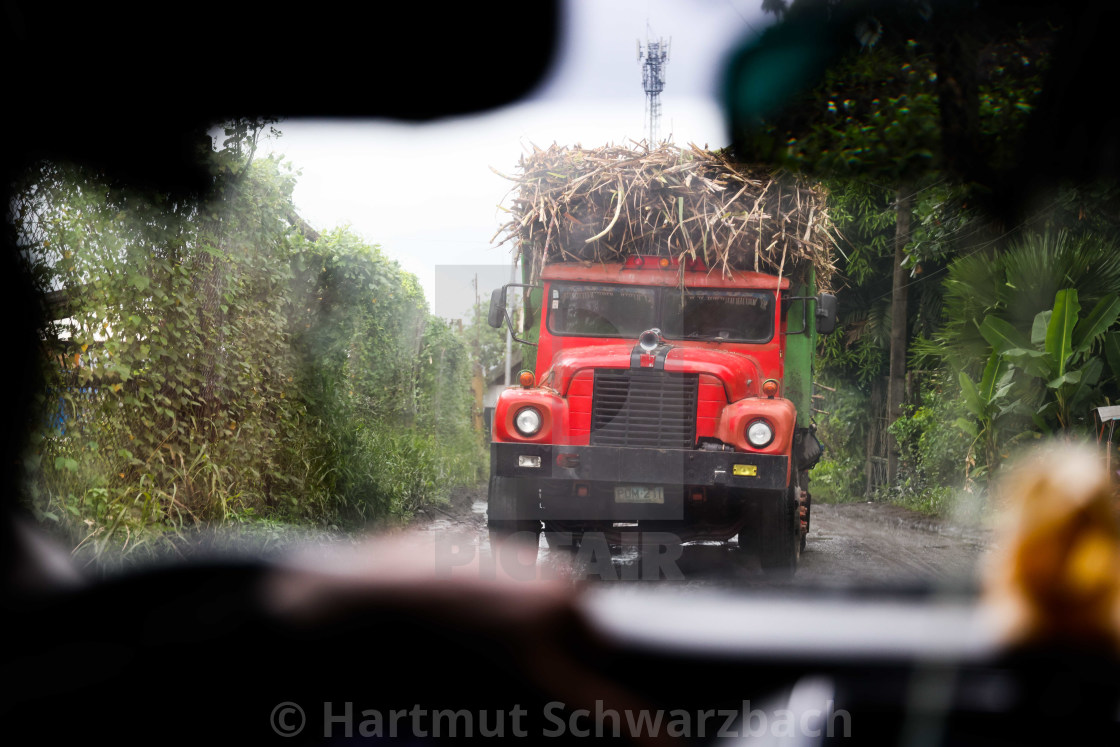
Zuckerrohr Plantagen auf Negros
Description
PHL, Negros, Western Visayas, Die Insel Negros ist das Zentrum der Zuckerindustrie auf den Philippinen. Die 13 Zuckermühlen produzieren 54% der Ernte des Landes. Schon arabische Händler brachten Zuckerrohr-Stecklinge vor der Kolonialisierung auf das Archipel. Die geschätzten 700.000 Erntearbeiter und Beschäftigten gehören zu den ärmsten und am schlechtesten bezahlten Arbeitern. Viele kommen als sogenannte Sakadas Migrant Workers/Erntehelfern aus noch ärmeren Provinzen der Nachbarinseln. Da sie nach dem Pakyaw System abhängig von der Erntemenge bezahlt werden, erreichen sie nicht einmal den gesetzlichen Mindestlohn der Landwirtschaft. Unter der sklavenähnlichen Beschäftigung hat sich also in den letzten Jahrzehnten kaum etwas gebessert. Auch Kinderarbeit ist nach wie vor verbreitet, vor allem beim Bestellen der neuen Feldern mit Setzlingen, da diese Tätigkeit technisch sehr einfach ist. Viele Kinder verbringen den Tag Stunden lang in gebückter Körperhaltung und gekrümmten Rücken und schwänzen die Schule. Die Kinder der Plantagenarbeiter haben keine Chance dem Teufelskreis der Abhängigkeit zu entgehen. Es fehlt an finanziellen Mitteln für die Ausbildung und an politischem Willen der Verantwortlichen, die Situation zu ändern. Im Alter von zwölf bis vierzehn Jahren beginnt ihr Arbeitsleben als Feldarbeiter. Die Zuckerindustrie gehört heute zu den Vorreitern alternativer und erneuerbarer Energiequellen, zu denen Biokraftstoffe durch die Produktion von Bioethanol und Kraft-Wärme-Kopplung gehören. Da der Weltmarktpreis des Zuckers sehr volatil ist und immer mal wieder abgestürzt ist, kam es in der Vergangenheit zu sozialen Spannungen und gewaltsamen Aufständen der Erntearbeiter. Auch während der EDSA Revolution 1986 kam der Zuckerindustrie und deren Plantagenbesitzer eine bedeutsame Rolle zu.
PHL, Negros, Western Visayas, Negros Island is the center of the sugar industry in the Philippines. The 13 sugar mills produce 54% of the country's crop. Arab traders brought sugar cane cuttings to the archipelago before colonization. The estimated 700,000 harvest workers and employees are among the poorest and lowest paid workers. Many come as so-called Sakadas Migrant Workers/harvest helpers from even poorer provinces on the neighboring islands. Since they are paid according to the Pakyaw system depending on the amount of harvest, they do not even reach the legal minimum wage for agriculture. The slave-like employment has hardly improved in the last few decades. Child labor is also still widespread, especially when cultivating new fields with seedlings, as this activity is technically very simple. Many children spend hours of the day hunched over and hunched over, skipping school. The children of plantation workers have no chance of escaping the vicious circle of dependency. There is a lack of financial resources for training and the political will of those responsible to change the situation. Their working life as field workers begins between the ages of twelve and fourteen. The sugar industry is now one of the pioneers of alternative and renewable energy sources, which include biofuels through the production of bioethanol and combined heat and power. Since the world market price of sugar is very volatile and has fallen from time to time, there have been social tensions and violent uprisings among harvest workers in the past. The sugar industry and its plantation owners also played an important role during the EDSA Revolution in 1986.
Details
8192 x 5464px
Formats
Digital Download
Printed Product
Buy
From $232.88